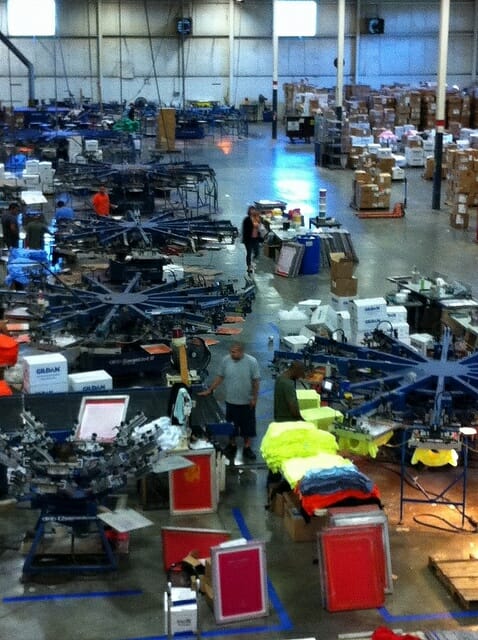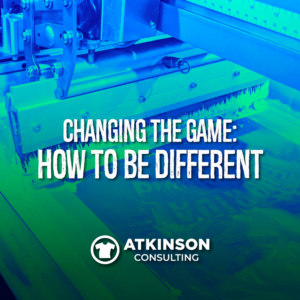
A guy e-mailed me from Bangalore India last week and wanted to know the formula for success in the t-shirt printing industry. Sorry to say, but listing everything needed to run a shop is a pretty complex task. It does, however, offer a great opportunity to jot down some ideas from my perspective to try to answer the question from a general success perspective.
To start I’m going to use a quote from Ayn Rand, “The ladder of success is best climbed by stepping on the rungs of opportunity”. Let’s define that quote with some examples:
First Rung: Skill. This could be skill as a business person, skill as an artist, skill as a printer. Do you have the skills to pay the bills? If not, what are you doing about it? I think skill has to be the first rung on the ladder, as this is the “thing” that drives us to start down a particular path. For me, my skill has always been art. I’ve been blessed with some creative talent. Looking back, I had a fourth grade teacher that noticed I would always turn over my homework paper and draw pictures instead of actually doing the assignment. During a parent – teacher conference she suggested that my parents develop this interest by sending me to a local community college art class over the summer. (I didn’t even get in trouble!) As a nine year old boy, I learned the skills with different mediums – water color, charcoal, pen and ink, scratchboard, pastels, and others. This was the first step in developing my creative skill that would eventually lead me to this industry. Acknowledging your skills, developing your skills, and taking action with your skills are what get you started on the ladder of success.
Second Rung: Knowledge. It’s been said that in order to become an expert at something you have to work a minimum of 10,000 hours to develop the understanding. How many hours have you put in? Where do you get those hours? Want to know the t-shirt industry? Do what everyone does and go to work for someone else. Top chefs don’t start off with their own fancy restaurant. They start off chopping onions somewhere else. You can take classes, read books, mess around and experiment on your own. The key to building knowledge is to get out there and get your hands dirty. Knowledge in this industry isn’t found by worrying about it over a desk; it’s found coating a screen, pulling a squeegee, trying to mix some ink, or working late hours to finish an order that has to be picked up tomorrow. Get your hours in.
Third Rung: Other People. No man is an island. Like any business, you need to interact and develop relationships with other people to be successful. It doesn’t matter if you are a one person shop, or run a company with hundreds of people; your success is going to be completely tied to your ability to develop long term relationships with other people. These people are your vendors, customers, educators, bankers, employees, etc. Developing trusting and mutually beneficial relationships with these people is crucial. Entire libraries are full of books dedicated to the quest of developing interpersonal relationships. My outlook has always been just a few core things: Be honest. Be helpful. Be yourself. Listen.
Fourth Rung: Failure. What? Climbing the ladder of success is based on failure? Of course. You aren’t always going to succeed. Things don’t go your way. You are going to make mistakes. It’s ok. Learn from them and build procedures or steps to eliminate them from happening again. Why did something fail? Figure it out. Printing is always a mix of art and science, with a good bit of old fashioned craftsmanship thrown in for good measure. How you handle these failures in your career will determine how your journey goes. Can you learn from them and adapt? Can you get up from the ground when disaster strikes? I’ve had some devastating blows in my career and have used them as a learning tool and catalyst to drive me onward.
Fifth Rung: Success. You land a big account. You learn how to print four color process. Maybe you finally purchase an automatic press. For many, there are certain landmark events in their careers that they talk about as when they knew that they “made it”. I love talking to other printers about their businesses and their growth over the years. Everyone has a great story to tell, and can point to a meaningful time or event that was extremely impactful. Often those events were years ago. So what happened after that? They kept on growing, learning and driving. Celebrate that landmark. Drink in the glory. Don’t rest on your laurels though, as there’s always another challenge. And that challenge is coming with an impossible order to print for a client. It is due Friday. Can you handle it?
Sixth Rung: Continuous Improvement. You’ve been at this business for years. Your shop is successful. Guess what? There’s always a better way to do something. There’s always new technology, inks, chemicals, processes, techniques or another “something” that you can use to refine your craft. Stagnant shops are usually on the downward slope towards failure. The ones that are constantly searching for something new, something that can help them, are the ones that keep moving forward and remain at the top. All businesses need to adapt, as market conditions, customer behaviors, and technology will change with a blink of an eye. For example, these days if you aren’t worrying about how you are competing with online competition instead of just that guy down the street, you may already be doomed. How are you adapting to the changing climate now? Shops that are constantly evolving, adapting and learning are the ones that will be around for another decade or two.
Seventh Rung: Best Industry Practices. As your company climbs to the top of the ladder in the industry, the wealth of knowledge and craftsmanship learned will eventually translate into your company doing things the right way, every time. From the way your customer service staff handles your clients, to the way your art is developed, screens are made, shirts are printed, orders shipped and the job invoiced…everything is a model of efficiency and perfection. Your staff is trained to think for themselves, make good decisions and communicate constantly on what’s next. Visitors to your shop can just walk through and will marvel at how you handle everything. Yet, your shop is never satisfied. Every department is always tweaking their processes, learning new skills, teaching others and growing. These top shops aren’t always the mega-huge shops either. They just have their act together. They’ve climbed the ladder rung by rung and are still reaching for the next level.
Eighth Rung: Leadership. Leaders take the position of “follow me”. They are usually the driving force into what’s next. Not only have these shops handled everything with aplomb, but at this level they give back to the industry by sharing their success with others. Sharing “here’s what’s worked for me” helps others flatten out the learning curve and makes our industry stronger. Want to know where this industry will be heading in a few years? Take a tour of these guy’s shops and see what they are working on, what equipment they are trying out, what ink they are testing, what software are they goofing around with late at night. They ask a lot of questions. They listen to a lot of people. Sharing information is important, as believe it or not, they are learning while they are teaching. Often, the leaders in our industry are also leaders in their own communities too. They sit on the school board, chamber of commerce, or volunteer with local philanthropies. How do you start to become a leader? It’s all about sharing your time, your knowledge, or your gifts without asking for anything in return. Leaders just do it.
Ninth Rung: The Unknown. This is the mystery that we all need to prepare for every day. Nobody can predict the future, but you can have a better chance of success if you open yourself up to as many opportunities as possible. Network with other people in other industries. Get active on social media. Volunteer. Read. Discover. Get out there and enjoy life. Be open to change.
At one point in time everyone wore hats. These were made from beaver skins, silk, straw, fabric…all kinds of materials. Think of English gentlemen, Abraham Lincoln’s stovepipe hat, cowboys, or even the typical 1940’s businessman. Sure, people still wear hats now – but not like before when every single person had something on their head. Like it or not, printing t-shirts is part of the fashion industry. Anything could happen. Cotton is already becoming a short supply commodity world-wide, digital printing is on the rise, governmental regulations are creeping into the industry, the minimum wage debate rages on… Factors that you don’t have control of can influence your business and your future. This is the unknown. Are you ready for this rung on the ladder?




